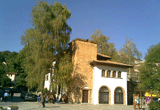 |
Teteven Municipality is situated in Lovech Region, north-central Bulgaria, in the Valley of Vit River, surrounded by the beautiful peaks - Petrahilja, Cherven, Treskavetz and other from the Zlatitza-Teteven area of the mountain. The highest elevations vary from 340 m to 2100 m. above sea level. The population of the municipality and the town itself is 25,000 and 12,000 respectively. The climate is temperate-continental, with a relatively mild winter and cool summer.
The mountain ridge is bare, while the south slopes are steep and treeless, the north slopes in their highest parts are heavily eroded, and in the middle the mountains are slanting and well-wooded, with nice beech trees. The forest offers nice surroundings for tourism and recreation that include walking, hiking, hunting, collecting of wild berries, herbs and mushrooms. There are good skiing conditions in winter and fishing and sunbathing conditions along the Beli Vit River and its tributaries during the summer. The beautiful cliff formations around Teteven offer good climbing conditions.
Numerous discoveries prove that the region was inhibited from ancient times – artifacts in caves and Thracian tombs.
Numismatic finds indicate that there was a Roman settlement here. Bronze and silver coins from the Roman emperors Trayan and Comodius, and other emperors of the II - IV centuries are not the only witnesses of Roman rule. Roman roads and watchtowers can be seen high in the mountains, as well as remains of Roman bridges over rivers.
16 and 17 centuries were periods of prosperity for Teteven. The town grew with houses so close to each other that one could go from one end of the town to the other just walking on the roofs of the houses. Twenty-seven crafts developed during this period. Teteven merchants went as far as Asia to the East and to Vienna to the West. There were 60 hadjias in the town (Jerusalem pilgrims). The town was called "Altan Teteven" – Golden Teteven.
Tourism is a vital pat of the local economy. Teteven region has a lot a national parks and protected reserves, house-museums and monasteries. Two of the biggest landmarks are the “Chernia Rut” protected reserve, where there is a huge diversity of birds; and the “Tsarichina” reserve, where there are more than 600 plants, some of which are in the Red Book of Bulgaria.
|












